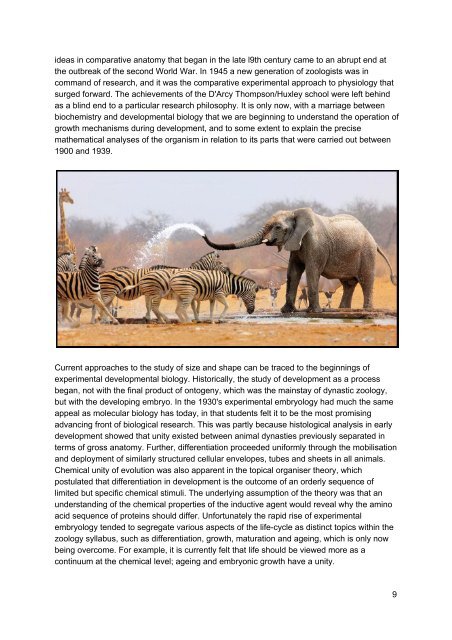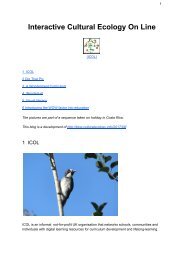scopeofzoology
Create successful ePaper yourself
Turn your PDF publications into a flip-book with our unique Google optimized e-Paper software.
ideas in comparative anatomy that began in the late l9th century came to an abrupt end at<br />
the outbreak of the second World War. In 1945 a new generation of zoologists was in<br />
command of research, and it was the comparative experimental approach to physiology that<br />
surged forward. The achievements of the D'Arcy Thompson/Huxley school were left behind<br />
as a blind end to a particular research philosophy. It is only now, with a marriage between<br />
biochemistry and developmental biology that we are beginning to understand the operation of<br />
growth mechanisms during development, and to some extent to explain the precise<br />
mathematical analyses of the organism in relation to its parts that were carried out between<br />
1900 and 1939.<br />
Current approaches to the study of size and shape can be traced to the beginnings of<br />
experimental developmental biology. Historically, the study of development as a process<br />
began, not with the final product of ontogeny, which was the mainstay of dynastic zoology,<br />
but with the developing embryo. In the 1930's experimental embryology had much the same<br />
appeal as molecular biology has today, in that students felt it to be the most promising<br />
advancing front of biological research. This was partly because histological analysis in early<br />
development showed that unity existed between animal dynasties previously separated in<br />
terms of gross anatomy. Further, differentiation proceeded uniformly through the mobilisation<br />
and deployment of similarly structured cellular envelopes, tubes and sheets in all animals.<br />
Chemical unity of evolution was also apparent in the topical organiser theory, which<br />
postulated that differentiation in development is the outcome of an orderly sequence of<br />
limited but specific chemical stimuli. The underlying assumption of the theory was that an<br />
understanding of the chemical properties of the inductive agent would reveal why the amino<br />
acid sequence of proteins should differ. Unfortunately the rapid rise of experimental<br />
embryology tended to segregate various aspects of the life-cycle as distinct topics within the<br />
zoology syllabus, such as differentiation, growth, maturation and ageing, which is only now<br />
being overcome. For example, it is currently felt that life should be viewed more as a<br />
continuum at the chemical level; ageing and embryonic growth have a unity.<br />
9




